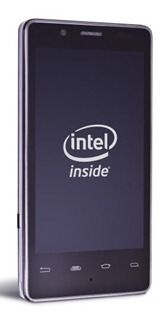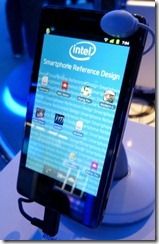 When I tested an Intel Menlow-based MID in July 2008 and saw the PC architecture streaming music into a browser-player running at 2.8W I knew Intel were on the right track. Two years later with their next-gen architecture, Moorestown, they tackled the standby power drain and managed to get it into a phone. I had exclusive hands-on and although the device was hot and eventually deemed uncompetitive, it was clear to see where this was heading. This week at CES I put my hand on the back of an Intel Medfield-based smartphone and felt nothing. No heat! On the front, I saw a quick user experience and when I tested Sunspider I saw an impressive result of 1290ms, with Android 2.x.
When I tested an Intel Menlow-based MID in July 2008 and saw the PC architecture streaming music into a browser-player running at 2.8W I knew Intel were on the right track. Two years later with their next-gen architecture, Moorestown, they tackled the standby power drain and managed to get it into a phone. I had exclusive hands-on and although the device was hot and eventually deemed uncompetitive, it was clear to see where this was heading. This week at CES I put my hand on the back of an Intel Medfield-based smartphone and felt nothing. No heat! On the front, I saw a quick user experience and when I tested Sunspider I saw an impressive result of 1290ms, with Android 2.x.
Over at AnandTech, meanwhile, Anand has been discussing more details about the performance and energy consumption figures. Not only are we seeing good performance but Intel are telling us that the efficiency is in the leading class too. The most impressive figure on the article? 1W browsing. That’s with screen-on and 3G-on. 1 WATT! Intel are now able to control a ‘PC’ to the point where everything turns off except the parts required. That doesn’t mean that Intel will be competitive in all areas though. Like Ultrabooks, the platform is likely to have a high ‘dynamic range’ and probably a higher system thermal design characteristic but if the work that Intel have done on Android is solid, that may not be a problem.
What a shame though that Meego wasn’t around to benefit from Medfield. I’m sure there are Meego devices in the Intel labs working just fine and I’m sure that Tizen is likely to re-surface too (My bet Samsung + Intel + Tizen make an announcement at MWC) but it would have been nice to see Intel’s Meego work result in a product. I wonder how Nokia are feeling at this point? With the N9 having been a success and the figures on Medfield/Android looking good, Intel may get sweet revenge!
 What Intel need now are product partners and platform advantages. Being competitive isn’t going to be enough to make the best product in the market so this is where 1080p hardware encoding, hardware-based image processing, Wireless-Display, McAfee and other technologies come into play. Intel Insider (for securely streaming first-run movies) and integrated radios, hardware encryption and of course, Intel’s silicon process advantage. if you consider how far Intel have come in the last 4 years, look at their technology portfolio and think about what’s going to happen in the next two years there should be no doubt that Intel will be playing, and possibly leading in the years to come.
What Intel need now are product partners and platform advantages. Being competitive isn’t going to be enough to make the best product in the market so this is where 1080p hardware encoding, hardware-based image processing, Wireless-Display, McAfee and other technologies come into play. Intel Insider (for securely streaming first-run movies) and integrated radios, hardware encryption and of course, Intel’s silicon process advantage. if you consider how far Intel have come in the last 4 years, look at their technology portfolio and think about what’s going to happen in the next two years there should be no doubt that Intel will be playing, and possibly leading in the years to come.
I won’t discount Cortex A15 and similar ARM architectures and we must not forget that ARMv8 is going to be feeding in after a few years but Intel’s position with Medfield now enables it to go and court some of its biggest customers for phones, tablets, set-top boxes and more and that partner ecosystem could be the real advantage for Intel.

I’m curious what made them slip in the first place?
Intel has “slipped” as you say for two reasons. First, they haven’t attacked the mobile market with their best process technology, probably because they saw it as a low performance, low cost arena. Second, they were slow to develop their System on a Chip (SoC – multiple capabilities on the same piece of silicon) and Multichip Module (MCM – multiple pieces of silicon in one package) capabilities.
They are still currently pushing to have their Atom processors on their leading process technology in 2014 by going to 22nm next year and 14nm in 2014. This means that they have quite a bit of process advantage to still take advantage of against ARM. They probably also will improve in SoC and MCM land as they work on more designs. Thus, while it is fair to say that Medfield is going to face better ARM competition in the near future, one must also consider that Atom will improve far more than ARM in the next 2 years. It is reasonable to expect Atom to be better hardware for mobile by the end of that time frame. The question is will there be good enough software and marketing to go with it?